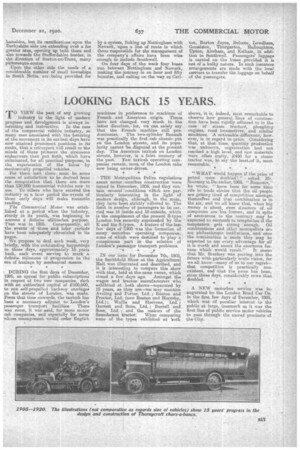LOOKING BACK 15 YEARS.
Page 25

If you've noticed an error in this article please click here to report it so we can fix it.
TO VIEW the past of any growing industry in the light of modern progress and development is always interesting and instructive. In the case of the commercial vehicle industry, so many men associated with the fostering of the movement in its earliest days have now attained prominent positions in its ranks, that a retrospect will recall to the minds of those pioneers the strenuous endeavours then put forth, which have culminated, for all practical purposes, in the supersession Of the horse • by mechanically propelled vehicles.
For these men there • must be some sense of satisfaction to be derived from the computation that there are more than 150,000 aommercial vehicles now in use. To others who have entered the industry at a later period the events of those early days will make romantic reading.
The Comanercial Motor was established at a. period when the industry, sturdy in its yoUth,.. was beginning to assume a defillite utilitarian purpose. That was in 1905. Consequently, all the events of those and later periods have been adequately chronicled in its pages. Weprepose to deal each week, very 'briefly, with the outstanding happenings in those days, approximately 15 years back, each event serving to mark a definite milestone of progression in the era of haulage by mechanical means.
DURING the first days of December, 1905, an appeal for public subscriptions in respect of two new companies, elich with an authorized capital of £100:000, to run self-propelled hackney carriages on the streets of London, was made. From that time onwards, the taxicab has been a necessary adjunct to London's passenger transport facilities There was room, it was said, for more motor cab companies, and especially for some whose management would order English machines in preference to machines -of French and American origin. Times have not changed very much in the latter direetiona for, we can safely say that the French machine still predominates. The two-cylinder Renault was practically the first cab chassis put on the London streets, and its popularity cannot 'be disputed at the piesent clay. The American taxicab on London streets, however, is a faint memory of the past_ Few taxicab operating companies remain, most of the London cabs now being owner-driven, THE Metropolitan Police (regulations anent motor • omnibus construction were issued in December, 1905, and they contain several 'conditions which are particularly interesting in the light of •• modern design, although, in the main, they have been strictly adherad to. Tho . limit in number of passengers to be car_ ried was 16 inside and 18 outside, which is the complement of the present B-type London bus recently superseded by the K and the S-types. Afeature of the last few • days of 1905 was the formation of many motorbus --operating companies, some of which were destined to play a conspicuous part in the solution of London's passenger transport problems. * . *
IN our issue far December 7thi, 1905, the Smithfield Show at the Agricultural Hall was illustrated and described, and it is interesting to compare this show with that, held at the same venue, which closed a few days ago. Amongst the wagon and tractor manufacturers who exhibited at both shows—separated by 15 years, as they are—we may mention Aveling and Porter, Ltd. ; Ruston and Proctor, Ltd. (now Ruston and Hornsby, Ltd.); Wallis and Steevens, Ltd. ; Garrett and Sons, Ltd. Burrell 'and Sons, Ltd. ; and the niakers of • the Saunderson tractor. When comparing some of the types exhibited at both
shows, it is, indeed, most remarkable to observe how general lines of construction have been rigidly adhered to in the ease of steam tractors, ploughing engines, road locomotives, and similar machines. A noticeable difference' how_ everais in regard to price. Considering that, at that time, quantity production was unknown, organization had not reached a high level, and raw materials were often costly, £450 for a steam tractor was, to say the Jeastaof it, most reasonable.
"-WHAT would happen if the price of petrol were doubled? " asi.cati. Mr. Sturmey in December, 1905. 'Rumours,"
he wrote, "have been for some time rife in trade circles that the oil people are getting tired of competition amongst themserves and that combina,tioh is in the air, and we all-know that, when big money is about, even directors of oil companies are but human, and in spite of assurances to the contrary may be expected to succumb to temptation if the temptation • gets strong enough. Oil combinations and other monopolists are not philanthropic institutions, and once the combination is made they may be expected to use every advantage for all it is worth and annex the enormous for tune which would result." It seems that Mr. Sturnmy was peering into the future with particularly acute vision, for we all know—many of us to our regret— that. competition is practically nonexistent, and -that the price has been, since those days, considerably more than
doubled.
A NEW motorbus service was in. _augurated by the London Road Car Co. in the first few days al December, 1905, which was of peculiar interest to the public at large, inasmuch as it, a as the first line of public service motor vehicles to pass through the sacred precincts of the City.
































